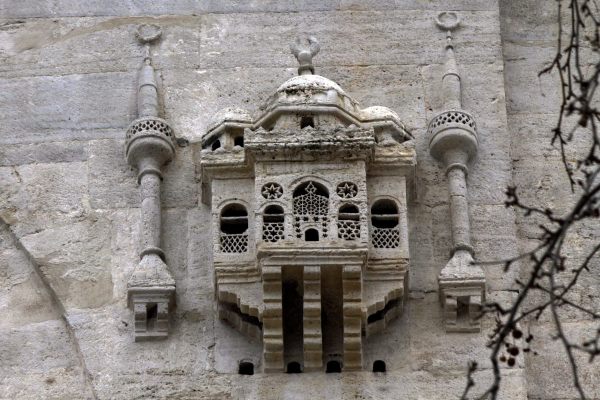What Pigeon Spikes Can Teach Us About People
Hostile architecture for birds has a lot in common with hostile architecture for humans.

On December 18, 2017, Jennifer Garrett, a self-described nature lover from Bristol, England, tweeted a photograph taken by her old colleague, Anna Francis. In the image, hundreds of spikes line a set of tree branches. The branches look somehow incorrect, like someone has transplanted a set of razor-tipped thorns onto the wrong plant. They also look like a very uncomfortable place for a bird.
This, of course, was the point of the points. These were “pigeon spikes,” Garrett wrote, spotted “in Clifton, Bristol above a car park.” Public response was swift. Within days, the tweet had thousands of outraged likes and retweets. The Guardian investigated, and traced the tree to a private apartment complex. “There is a big problem with bird droppings around here,” an anonymous resident explained to the outlet. “They can really make a mess of cars.”
Our war on wildlife: now birds are not allowed in trees…?! Pigeon spikes spotted in Clifton, Bristol above a car park. Has anyone seen this before? How is it allowed?!
— Jennifer Garrett (@JMAGarrett) December 18, 2017
📷: thanks to Anna Francis pic.twitter.com/NuG9WvYBMj

Plenty of outlets have taken the opportunity to rail against the implications of literally keeping birds out of trees, calling the car-owners “snobs” and the strategy “idiotic.” But the lessons inherent in this particular controversy aren’t pigeon-specific—or at least, they shouldn’t be. If we look at them in the right light, at least one pair of experts think they can teach us something about how we build spaces for humans, too.
Architect Selena Savic and designer Gordon Savicic, the duo behind the blog and book Unpleasant Design, have been keeping tabs on anti-pigeon measures for a while. Once symbols of fertility and peace—they are technically doves, after all—pigeons have taken to cities en masse, and are now largely considered to be nothing more than urban pests. “Pigeons [struck us as] this unwanted species… a cohabitant we used to welcome, and now increasingly want to exclude,” says Savic.
For a case study a few years ago, called “Unpleasant for pigeons,” Savic and Savicic collected data on pigeon prevention from news stories, bird-related discussions on blogs and message boards, and personal observation. They came away with a long list of interventions in use, including netting, electrified wires, fake birds of prey, and, of course, metal spikes. A quick search reveals even more types available: chimney cowls, pieces of plastic that turn flat surfaces into slopes, and board-and-mirror setups that display flashing human eyes.

To Savic and Savicic, these strange gadgets aren’t just proof of humanity’s endless inventiveness in the face of bird droppings. They’re also reminiscent of what urban design experts call “hostile architecture”: infrastructural decisions that purposefully keep people from using a space’s attributes in ways that authorities deem unwanted. Examples of this are everywhere. Park benches are designed to be good for sitting, but bad for lying down, to keep people without homes from sleeping on them. Sprinklers go off at random so that loiterers stay away.
The motivations behind pigeon- vs. people-focused hostile architecture are, of course, different. So are the effects. But, Savic says, both “are part of the same principle of hard-coded exclusion,” in that they both assume that the best solution to a potential conflict is forcing the bird or human to find another place to be. In Savic’s view, focusing on anti-bird measures “[can] show, sometimes more clearly, how the policy of moving the problem somewhere else operates on urban space.”
These particular spikes make for an especially blatant example; after all, “birds are supposed to sit on trees, we like to think,” says Savic. The juxtaposition between spike and branch may be responsible for all the public uproar, even as other anti-bird measures take place without much of a peep.

On the other hand, Savic says, “it is always hard to pinpoint exactly what is natural. Those trees in Bristol were planted by people… it is perfectly legal to install something on them, and it makes even more sense if we think of the damage bird excrement causes to car paint.” (It also may be better than certain alternatives—in an interview with Devon Live, pigeon spike maven David Jones said that plenty of management companies choose to simply kill pigeons rather than putting up spikes.)
“But then,” she continues, “where do we stop?” If we do decide the relationship between birds and their roosting sites is something we want to control, perhaps there are better ways to do this: ways that do not, as Savic puts it, “cause the interests of people and pigeons to crash.”She points to one striking idea: A few years ago, two artists, Revital Cohen and Tuur van Balen, speculated about feeding pigeons special bacteria that gave their droppings the properties of soap.*
In the end, as increasingly powerful shapers of our environment, it’s really up to us which trajectory we want to follow, both with pigeons and each other. “If we design space for conflict, we will have conflict,” Savic concludes. If we don’t, we could have something else instead.
*Correction: This post previously stated that Revital Cohen and Tuur van Balen fed pigeons special bacteria. They only speculated about doing so.

























Follow us on Twitter to get the latest on the world's hidden wonders.
Like us on Facebook to get the latest on the world's hidden wonders.
Follow us on Twitter Like us on Facebook